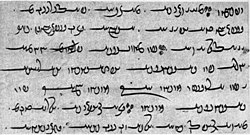Yasna
Yasna ( Avestian ) is the name of the primary liturgy of Zoroastrianism and the most important part of the writings of Avestas , the sacred collection of writings of the followers of the teachings of the Iranian religious founder Zarathustra . Accompanied by ritual acts, the recitation of this liturgy is also the most important religious ceremony of the Zoroastrians.
About the name
The word "Yasna" (also "Jasna") means "to worship, sacrifice, praise"; Also related to Yašt and Yazata via the root word yaz . The scripture collection takes its name from the ceremony for which it is recited. The term Yašn is derived from “Yasna” in Middle Persian , and the term Ǧašn (جشن) in New Persian . The latter remains a commonly used term in today's Iran and in the entire Persian-speaking area and denotes a happy holiday there.
The liturgy
The Yasna liturgy is an integral part of the Avesta . The Yasna consists of 72 " Hâ s" or " Hât s", from the Avestian ha'iti , "cut", corresponding to "section".
Part of the Yasna - in addition to the linguistically differently younger sections - are the Gathas . These are hymns which can be distinguished from other parts of the Yasna both in terms of style and linguistics as well as in terms of content and are traced back to the person of Zarathustra. The seventeen hymns of the five gathas are also sections 28–34, 43–46, 47–50, 51 and 53 of the Yasna collection.
The first sections of the Yasna contain invocations and prayers to the Zoroastrian ancient Iranian pantheon (the Yazata ), whose presence is requested during the "worship". Yasna 9 to 11 correspond to Hom Yasht, which like the other Yashts of Yasna does not belong to the Yasht collection . In terms of content, Yasna 12 represents a commitment to the Zoroastrian faith. Part of the content relates to other sections of Yasna and is an explanation of the same. The "Ahuna Vairya", the most important of the four Zoroastrian prayers ( mantras ), can be found in Yasna 27. Yasna 55 contains a hymn of praise to the Gathas. Yasna 63–69 form the prayers that are accompanied by the Ape-Zaothra ritual in the ceremony . The last three sections are thanksgiving to the Yazata who were initially called.
The ceremony

"Yasna" is the most significant religious ceremony of the Zoroastrians. As an "inner" ceremony, ie performed in ritual purity and thus at the altar of a fire temple , it takes place in two steps:
In the first step, preparations are made, including the consecration of the area where the ritual takes place and the preparation of the first Parahaoma mixture.
The second step is the actual Yasna ceremony, a recitation of the liturgy from memory, accompanied by several ritual acts, including the preparation of a second Para haoma mixture. The culmination and ultimate objectives of the ceremony, the Ape-Zaothra ( Middle Persian and New Persian : from Azor , literally "gift / gift to the water"), strengthening of water caused by a mixture of the two Parahaoma is done symbolically -Preparations.
The “inner” and “outer” Yasna ceremonies can each take several hours and, like most Zoroastrian rituals, are performed in the face of the sacred fire, which - in Avestian called “Atar” - in the world of the ancient Iranian religion Represents purity and truthfulness ( Asha ) and to which in the Pahlavi literature Asha Vahishta ( Aša Vahišta ) is assigned as the protective power . Yasna (Hât) 62 des Avestas is dedicated to Atar.
While, as attested from the Sassanid period, the recitation used to be done by eight Zoroastrian priests (Middle Persian: “Magu-pat”, New Persian “ Mobed ”), today it is usually performed by two. The celebrant is the Zut (Avestisch: Zaotar ), and his assistant, who is also responsible for the preparations, is one or more Raspis .
The word “Zaotar”, like “Yasna”, has an Indo-Iranian origin and is etymologically related to the Vedic Hotar . In the Gathas, Zarathustra calls himself Zaotar. In the Middle Persian book Bundahishn , this term is applied to Ahura Mazda in the resurrection .
literature
- Encyclopaedia of Ancient Iran . Hashem-e Razi, Tehran, Sokhan, 2002.
- Encyclopedia Iranica . Edited by Ehsan Yarshater
- Translations: J. Darmesteter, LH Mills, F. Wolff. See also www.avesta.org .
- Old Avestan Glossary . P. Octor Skjaervo, Harvard University.
- Avesta. Translation of the text . Jalil Doostkhah. Morvarid, 1996.
- A Concise Pahlavi Dictionary . DN MacKenzie. Routledge Curzon, 2005.
Notes and individual references
- ↑ lit. "Lord of Magi" ( magu- ; neupers. Moġ ); medium pers. pat corresponds to neupers. bod = "Lord".
